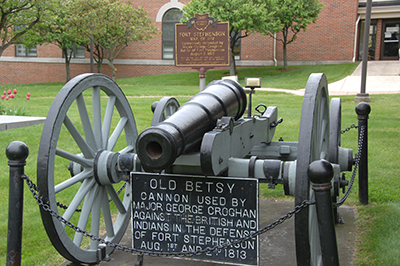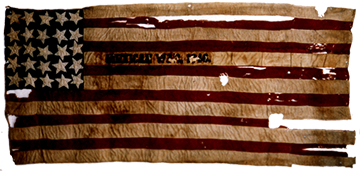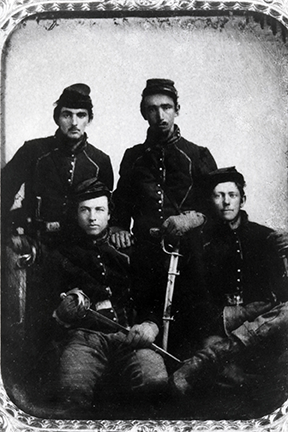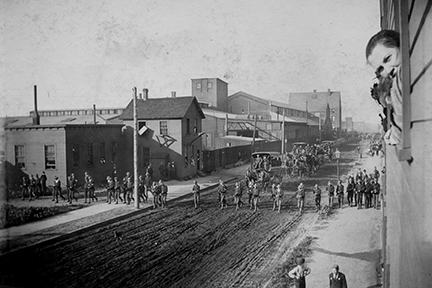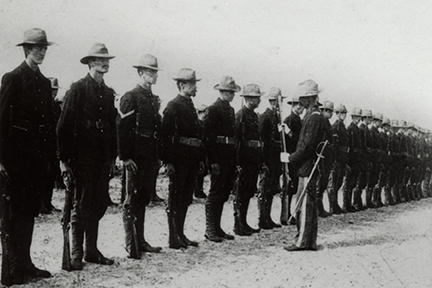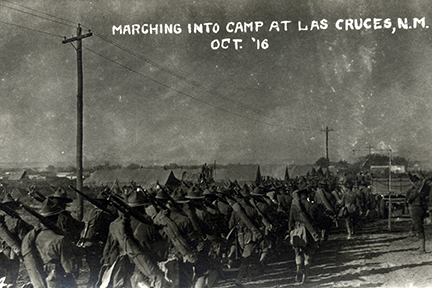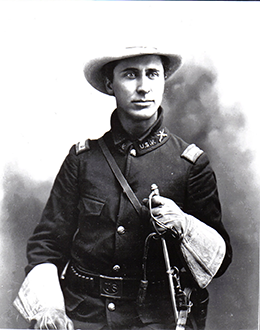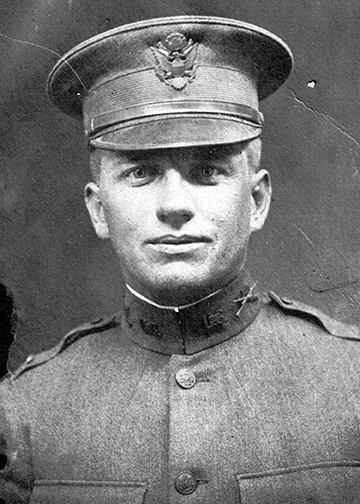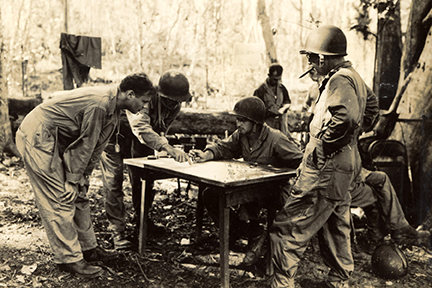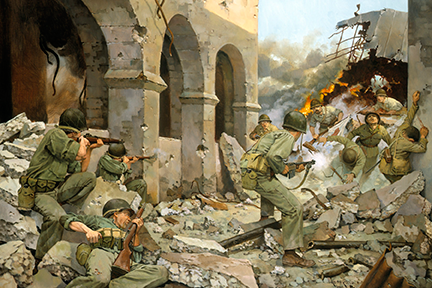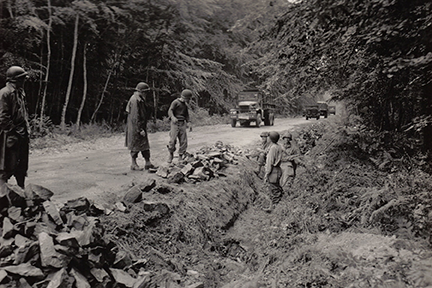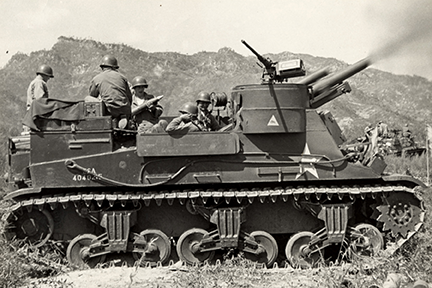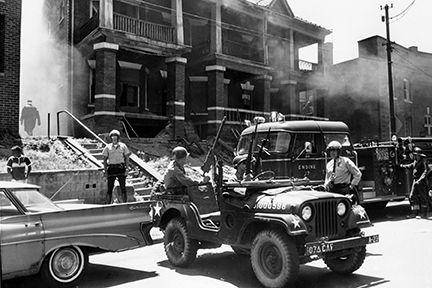Ohio National Guard History
The first law enacting the militia was made well before Ohio became a state. The early settlers of the Northwest Territory recognized the need for an organized militia. As settlers spread across the wilderness, the militia was there to defend against British backed Indian attacks. One of the first statutes of the State of Ohio in 1803 was the militia law, which stated what class of persons was to be in the militia, the equipment each man was to furnish, how officers were to be elected and how the state was to be organized. Ohio's first call came shortly after achieving statehood. Talk of a second war with England began in early 1812. Ohio was tasked with organizing twelve hundred men in anticipation of the coming struggle. In response, three regiments of Ohio Militia were assembled at Dayton in May and by July, had marched to Fort Detroit. In August, General William Hull prematurely surrendered Fort Detroit with the entire garrison, including the Ohio Militia. The surrender left western Ohio vulnerable to British and Indian attacks. In response, General William Henry Harrison built a new fort along the rapids of the Maumee River, near present day Toledo. Named for the Governor of Ohio, Return Jonathan Meigs, the garrison was a home for more than 2,000 men. The British and their Indian allies would lay siege to Fort Meigs twice in the spring of 1813. Defended by regulars and militia, they managed, in some cases barley, to hold out. The fort was very strong and the British could not breech the walls, their artillery did very little damage.
The victory at Ft. Meigs began to turn the tide of the war for the Americans. In August, Ohio Soldiers were again facing a British attack, this time at Fort Stephenson, near Fremont. Although strongly outnumbered, the garrison utilized their resources to the maximum to defend the fort. They had one cannon, which they affectingly call “Old Betsy.” Each time they would fire “Old Betsy” they would move her very quickly to another spot on the ramparts, fire her again as fast as they could, so the English actually thought there were more guns there then there were. The devastating fire broke the back of the enemy and the attack was repulsed. The British moved north in defeat; marking the last time they would take to the offensive in Ohio. Seventeen hundred officers and twenty-four thousand buckeye Soldiers responded to the first call of Ohio's military force. Shortly after the end of the war, the common militia system across the country began to collapse. In response to this military void, a phenomenon known as independent militia companies began forming across the state. Citizenry in each town or hamlet, throughout the state banded together to form independent companies. In Ohio's cities, prominent men formed such groups as the Cleveland Grays, Cincinnati Rover Guards and the Columbus Fencibles. Even though these independent companies were organized under state law, they do not receive any funding from the state or federal government. In essence they are privately armed and equipped out of their own pockets. Because of this, memberships in these companies are reserved for the socio-economic elite of the given community. They become known more for their colorful uniforms, lavish military balls, and social stature. However, these units provide a military presence in the absence of the ordinary militia and contain young men who are ready to rally around the colors when the call comes.
That call would come when War with Mexico was declared in May 1846. Within two weeks, three thousand buckeyes answered President Polk's call and were marching toward the rendezvous at Camp Washington, near Cincinnati. By June, forty companies were in their tents and by August, Ohio's 1st Regiment had seen its opening action under General Zachery Taylor at Monterey. Ohio military forces were organized into five infantry regiments, fifteen independent companies of infantry and one company of mounted rifleman. So many buckeyes answered the call that five companies were supplied to the Fifth United States Infantry. In the end, there were about seven thousand officers and men in the Mexican War from Ohio. This constituted about one-eighth of the entire land forces of the United States. Just fifteen years later, the Buckeyes were called again. In the early morning darkness of April 12, 1861, confederate batteries opened fire on Fort Sumter in South Carolina. Before the bombardment had ended twenty companies were offered to the Governor for service. By April 18, enough companies had arrived in Columbus to organize two regiments. With Washington in danger the Government called for an immediate presence. Before daylight on the morning of April 19, without arms, accoutrement or uniform, Ohio's first contribution to the Civil War left Columbus for the defense of a divided nation. When the war came to end four years later Ohio had supplied a total of 319,000 men to the call, of which 35,000 did not return. As a testament to their dedication more than 200,000 three-year soldiers re-enlisted at the expiration of their time and fought until the war ended. Among the one hundred forty four Ohio Soldiers that were decorated with the Medal of Honor was a group of twenty men, known as “Andrew's Raiders”, who were the first to be presented with the award. Flags of 230 different regiments flew over virtually every battlefield the Union Army fought on.
In addition to the volunteer militia's service on the front line, the title Ohio National Guard was first used in 1864 when Governor Brough organized forty-one regiments for the defense of Washington. Although their time served was brief, the buckeyes, affectionately referred to as “One Hundred Day Men”, garrisoned the defenses of Washington, thereby releasing 35,000 veterans who were transferred to General Grant's army for the Wilderness campaign. At home, National Guard regiments guarded confederate prisoners at Camp Chase in Columbus and along Lake Erie at Johnson's Island. Following the conclusion of the war, the Ohio National Guard began a slow restructuring process into a more organized and professional branch of Ohio's Government. Legislation in the early 1870s paved the way for this as Ohio lawmakers began to provide more funding for the peace time Guard and companies of men organized in nearly every community throughout the state. Regulations for drill, uniforms and equipment were outlined and sternly maintained by the Adjutant General. Any companies not in agreement with these standards were immediately disbanded and only the best survived.
| ||||||||||||||||||||
This period marks a third of a century of peace in the United States. However, for the Ohio guardsman this was not the case. The Great Railroad Strike of 1877 began nearly twenty years of labor unrest across the state and nation. Violent strikes frequently flared up in cities where workers struck for what have come to be known as the “bread and butter” issues of labor: better pay, shorter hours and safe working conditions. In Cleveland and Columbus, Toledo and Cincinnati, guard and independent companies worked side by side with local officials to protect lives and property. The conduct of the units confirmed that the Ohio National Guard had slowly transitioned from a social organization into a group of well trained and disciplined officers and men, who could answer the call when the citizens of Ohio needed them the most. In April 1898, Congress declared War with Spain. Over 15,000 men answered the call for volunteers and organized at Camp Bushnell, near Columbus. Although Ohio would send the first volunteer regiment into the field, the war would end before most units could even leave the United States. Only Ohio's 4th Infantry, in Puerto Rico, and 8th Infantry, in Cuba, saw combat. Many Ohio officers took regular army commissions and served in China and the Philippines. Major Web Hayes, formerly of the 1st Ohio Cavalry, was one of those men. The son of President Rutherford B. Hayes, he served in the Philippines and received the Medal of Honor for his actions to rescue men there. One of the key periods in the history of the National Guard occurred following the War with Spain. The Militia Act of 1903 was passed, known to many as the “Dick Act”, so named for the bills sponsor, Senator Charles Dick, who was also a Major General in the Ohio National Guard. The act gave increased federal funds and equipment to the National Guard. In return guard units were required to conform to regular army standards and were subject to inspection by regular army officers. It transformed the militia from individual state forces into a Reserve Component of the Army. Outside the United States Constitution, the Dick Act coupled with the National Defense Act of 1916, became the most important piece of legislation in the history of the guard.
Charles Dick became the father of the modern National Guard and was able to see his labors bear great fruit in 1916 when the Ohio National Guard was mobilized for service along the Mexican Border. Over 7,000 soldiers mustered at Camp Willis, near Upper Arlington, in June and began to arrive in Texas by late August. Although service on the Mexican Border was reserved to routine patrolling and basic military training, the patrols were important and the training the Guardsman received was invaluable. Additionally, the lessons learned from the mobilization process would set the stage for the bigger mobilization that would occur a year later. More importantly, Guardsmen were physically toughened and officers and NCOs gained experience in handling troops in the field allowing many of them to develop the necessary skills needed to lead men in combat. By early 1917, as Ohio units returned from the border, tensions between the United States and Germany had erupted into open hostilities. On April 6, 1917, America declared war on Germany. The Ohio National Guard quickly recruited to war time strength, adding the necessary units to form a complete division. When the entire National Guard was drafted into Federal service on August 5, 1917, the Ohio Division was sent to Camp Sheridan, Alabama. It was here that the 37th Division was born.
After months of training, the “Buckeye” Division was sent oversees and fought courageously on the battlefields of France and Belgium. The Buckeyes led the assault in the Meuse-Argonne campaign. During this fight, near the town of Ivoiry, France, Second Lieutenant Albert Baesel of the 148th Infantry gave his life attempting to rescue a wounded Soldier under fire. For his actions, he was posthumously awarded the Medal of Honor. As the war reached its final days, the Buckeyes forced the crossing of the Lys and Escaut rivers and were knocking on the door of Antwerp when the war ended. As a testament to their distinguished record, a division honor guard was selected to escort King Albert upon his re-entry into Belgium. Praise for the action of the 37th in combat was found in a statement made by the German general staff as the Buckeyes was named one of the best seven American divisions the Germans faced. All of Ohio's contributions to the Great War were not reserved to the 37th Division. The Fourth Ohio Infantry was selected for the organizing 42d Division. The Rainbow Division was the third American unit to arrive in France and was so named because its units were drawn from 26 states and the District of Columbia. The 4th Ohio became the 166th Infantry and fought continuously from February 1918 until the end of the war in November. Finally, the Ninth Battalion of Infantry, an all African American unit, was consolidated with other segregated National Guard units to form the 372d Infantry. In France the 372d was assigned to the French 157th “Red Hand” Division, so named for the red hand on the Shoulder Sleeve Insignia adopted by the men. The 372d received the French Croix de Guerre for their actions in the Meusse-Argonne Campaign and Lieutenant Robert C. Allen, one of the few remaining black officers in the regiment, became the first African-American to receive the Distinguished Service Cross. The Ohio National Guard quickly began reorganizing following World War I. The inter-war years marked a defining time for the Buckeyes. Weekly drills in newly constructed armories across the state and annual encampments at Camp Perry sharpened the military preparedness of Ohio Soldiers. In 1927, the 37th Division Aviation was organized at the Central Armory in Cleveland, adding the first flying unit to the Ohio National Guard. It had 101 men, but no airplanes or building. The first anniversary of the 112th was marked by the dedication of a new hangar at Cleveland Hopkins Airport and four aircraft. They were called the “greatest generation”. Their service during the Second World War wrote the “greatest chapter” in the history of the Ohio National Guard. It began on October 15, 1940 when the 37th Division was called into federal service. In March of the following year, the 107th Cavalry and 2d Battalion, 372d Infantry Regiment joined them. Their enlistment was to be for one year. However, the raging war in Europe and the Japanese attack on Pearl Harbor in December reserved the buckeyes to an open ended stay. Company C, 192d Tank Battalion was the first unit to see combat, just hours of Pearl Harbor. The Port Clinton unit had just arrived in the Philippines when the Japanese attacked the islands. Completely cut-off from being re-supplied the entire American force surrendered in April 1942 and the men became part of the Bataan Death March. The Soldiers were forced to march for two weeks in the hot sun with little water and food. Those that survived the enemy brutality became prisoners of war for the next 3 years.
Those that remained in the Philippines were liberated by their buckeye brothers from the 37th Infantry Division in 1945. However, this was not the beginning of their story. Under the leadership of Major General Robert S. Beightler, the “Buckeye Division” trained for over two years at Camp Shelby, Mississippi and Fort Indiantown Gap, Pennsylvania. In the summer of 1942 the division arrived in Fiji and coupled with a vigorous jungle training program, established and manned the defense of the island. They were battle-wise but not battle tested. Their baptism of fire was not far away. That baptism came on New Georgia in July 1943. This tiny island in the Solomon's, where it not only fought the fanatical Japanese, but the thick, disease infested jungles, proved the division's worth in battle. The 37th seized their objective, Munda Airstrip, in just over a month. Their achievements were not without a price. On July 31st, two men, Private First Class Frank Petrarca, a medical aid man in the 145th Infantry, and Private Rodger Young, of the 148th Infantry, earned with their life the Medal of Honor. The 37th Division had little time to reflect on their New Georgia accomplishments when they were sent to the neighboring island of Bougainville. The mission for the Buckeyes was simple; establish a secure perimeter around two airstrips and leave the enemy alone. However, in March 1944, the Japanese made a desperate attack on the center of the division at Hill 700 with the goal to drive the Buckeyes into the sea. The enemy briefly gained a stronghold on Hill 700. After a day long fight, Hill 700 was secure. But that battle was not over. This time the enemy swerved to the right and attempted to penetrate the 129th Infantry lines. Their plan failed. When the smoke cleared, over 7,000 enemy Soldiers lay dead. General Beightler flatly stated that his one-time farmers, factory workers, miners and office men from America had out-scouted, out-maneuvered, out-fought and above all, out-lived the best the Japanese had been able to throw against them.
In January 1945 the 37th Division landed at Lingayen Gulf to lead General Douglas MacArthur's return to the Philippines. Once ashore, the buckeyes covered 140 miles in 24 days to reach the capitol of Manila. For nearly a month after that they fought street to street, building to building and room to room with fanatical Japanese making a last stand in the city. By the time the fighting in Manila had ended, four Soldiers of the 148th Infantry had performed such heroic acts that they were awarded the Medal of Honor. PFC Anthony Krotiak, Tech Sergeant Cleto Rodriguez, PFC John Reese Jr. and Lieutenant Robert Viale. The final push came as the division chased the Japanese out of Bagio and up the Cagayen Valley. At Moyoko Mountain, PFC Anthony Krotiak threw his body on a grenade and sacrificed his life to save his buddies. He became the seventh Buckeye Soldier to receive the Medal of Honor during the war. The Buckeyes got the word to cease fire on August 15, 1945. The war for the Buckeyes was over. The 37th Division spent five years in active service, totaling 592 days in combat without relief for rest or recuperation. They fought offensively and defensively -was constantly in fever infested jungles — engaged in amphibious landings and the bitterest of street fighting — and attained every assigned objective. It was never defeated. In addition to the 37th Division multiple Buckeye units served with honor and distinction. The 112th Engineer Battalion was sent to Europe and supported the 1st Infantry Division on the beaches of Normandy, landing at Omaha Beach in the first waves of the invasion. The 147th Infantry saw action in the Pacific at Guadalcanal and Iwo Jima. After patrolling the west coast for over a year, the 107th Cavalry Reconnaissance Squadron was sent to Europe and conducted reconnaissance missions for various major commands. On the east coast, the 112th Observation Squadron flew anti-submarine patrols from Pope Air Force Base in North Carolina. While the aviation units retained their designations, most lost their character as guard organizations. Over time personnel were moved to form cadres of new squadrons in the rapidly expanding army air corps. Some, like Lieutenant Colonel Addison Baker achieved important leadership positions. The former Buckeye was commanding the 93rd Heavy Bombardment Group during a daring low-level attack on the oil refineries at Ploesti, Romania. His B-24, “Hell's Wench” was badly damaged by anti-aircraft artillery fire. He refused to break up the lead formation by landing, and led his group to the target upon which he dropped his bombs with devastating effect. Then he left the formation, but his valiant attempts to gain enough altitude for the crew to escape by parachute failed and the aircraft crashed. For his gallant leadership and extraordinary flying skill, both Baker and his co-pilot received the Medal of Honor. When reorganization of the Ohio National Guard began following the war, it was for the first time split into 2 separate organizations, the Army and Air National Guard. For nearly three years the Ohio Army National Guard reorganized into the 37th Infantry Division, 166th Regimental Combat Team, 107th Armored Cavalry Regiment and various other non-divisional support units. The Buckeyes had little time to get settled. In 1950, the United States found themselves fighting communism on battlefields in Korea. Many Ohio units were called up and were used to back-fill active duty organizations sent to Korea. Ohio provided a vast cadre of World War II veterans that were vital in training and preparing new Soldiers for life in combat. Ohio’s largest organization, the 37th Infantry Division, was federalized in 1952 and sent to Camp Polk, Louisiana. After completing a short training period, virtually every Soldier was sent to Korea as an individual replacement, carrying with them the spirit of the Buckeye Division.
Ohio sent only one unit to the battlefields of Korea, the 987th Armored Field Artillery Battalion, stationed in Canton and Alliance. The “red bulls” as they were known, distinguished themselves in support of various Army, Marine and Republic of Korea forces. By the end of 1954 units in Federal service had reverted to state control. The great period that is known as the Cold War saw Ohio Soldiers serving both the state and nation in a variety of assignments, places and missions. In October 1961, Soldiers were ordered by President Kennedy into active service for the Berlin Crisis. This period also marks some of the most significant changes in the type of units allotted to Ohio Army National Guard. In sweeping changes across the Army, multiple National Guard divisions, including the 37th Infantry Division, were removed from the force, leaving the remaining divisions spread across state lines. On February 15, 1968, the 37th Infantry Division cased their colors. The 51 year legacy of the Buckeye Division was to be carried on by new organizations. The 73d Infantry Brigade and 16th Engineer Brigade both rose from the ashes of the mighty Buckeye Division and carry on their shoulders the heritage of one of the finest units in U.S. Army History. These units would not have much time to reflect on their past accomplishments, as they were writing new history, without even leaving the borders of Ohio. Throughout the 1960's and 70's race and labor riots flared up in major cities around Ohio. On college campuses, anti-war protests often turned violent and completely shut down universities. Buckeye Soldiers and Airman were called upon to restore order and keep the peace from Lake Erie to the Ohio River. Cleveland's Hough and Glenville neighborhoods turned into war zones and Buckeye Soldiers patrolled the streets, provided security for firefighters and helped restore order. On January 25, 1978 a storm of unprecedented magnitude plowed into Ohio, dumping upwards of 40 inches of snow across the state. Wind gusts of 100 miles per hour, buried cars and homes in snow drifts. Wind chill values reached sixty below across much of Ohio. In response, Buckeye Soldiers and Airmen went to work. Engineers from both services used bull dozers and other engineer equipment to clear roads. Soldiers on the ground dug stranded motorists from snow drifts. In the air, Ohio helicopter crews performed life saving operations that no one else could perform. Not until 1990 would Ohio again answer that call, this time in the deserts of Southwest Asia. When the military machine of the Iraqi dictator Saddam Hussein overran Kuwait in an unprovoked display of raw aggression, the Ohio Army National Guard again responded in exemplary fashion. On the ground one thousand soldiers from 9 Army units were deployed, seven seeing service in Southwest Asia. Transportation and Military Police units provided a critical combat service and support role leading up to the ground war. The success of Desert Storm showed that the National Guard could deliver highly trained units to the fight. This would become critical as the United States began to draw down the size of its Cold War military. Soldier's maintained peace in Bosnia, rebuilt homes in the jungles of Central America and faced the devastation of Mother Nature in the streets of Ohio. When terrorist attacked the homeland in 2001, Ohio Soldiers did not hesitate to answer the call to duty, just as Ohio Soldiers had been doing for over 200 years. Just weeks after the attacks Soldiers were called upon to provide additional security in Ohio’s airports, while others deployed throughout the Midwest to provide force protection at key instillations and military bases. Beginning in 2003, Ohio units received the call for missions in Afghanistan and Iraqi. Since that time, more then ten thousand Soldiers have deployed in support of the War on Terrorism. In addition to active roles in combat theaters, Buckeye's have continued to perform vital peacekeeping and humanitarian missions from the mountains of Kosovo, the sands of Egypt to the jungles of Central America. When Hurricane Katrina and Rita smashed into the shores of Louisiana and Mississippi in August 2005, Ohio again responded to a call, this time from their fellow Americans. Within 24 hours, Ohio Soldiers, transported by the planes of the Ohio Air National Guard, arrived in New Orleans and were assisting in the evacuation of the Louisiana Superdome. Follow on missions of search and rescue, medical aid and filling sandbags capped off the largest deployment for a domestic emergency in the history of the National Guard. The deployments have not been easy and we have once again affirmed the creed that freedom is not free.
|
